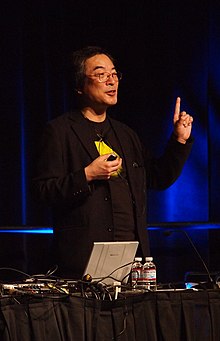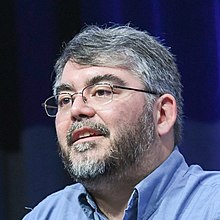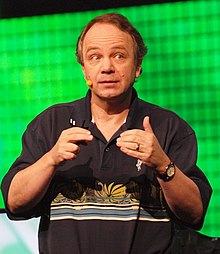Portal:Video games
The Video Games Portal

A video game or computer game is an electronic game that involves interaction with a user interface or input device (such as a joystick, controller, keyboard, or motion sensing device) to generate visual feedback from a display device, most commonly shown in a video format on a television set, computer monitor, flat-panel display or touchscreen on handheld devices, or a virtual reality headset. Most modern video games are audiovisual, with audio complement delivered through speakers or headphones, and sometimes also with other types of sensory feedback (e.g., haptic technology that provides tactile sensations). Some video games also allow microphone and webcam inputs for in-game chatting and livestreaming.
Video games are typically categorized according to their hardware platform, which traditionally includes arcade video games, console games, and computer (PC) games; the latter also encompasses LAN games, online games, and browser games. More recently, the video game industry has expanded onto mobile gaming through mobile devices (such as smartphones and tablet computers), virtual and augmented reality systems, and remote cloud gaming. Video games are also classified into a wide range of genres based on their style of gameplay and target audience. (Full article...)
Featured articles –
Grim Fandango is set in the Land of the Dead and the retro-futuristic version of the 1950s, through which recently departed souls, represented as calaca-like figures, travel before they reach their final destination. The story follows travel agent Manuel "Manny" Calavera as he attempts to save new arrival Mercedes "Meche" Colomar, a virtuous soul, on her journey. The game combines elements of the Aztec afterlife with film noir style, with influences including The Maltese Falcon, On the Waterfront and Casablanca.
Grim Fandango received praise for its art design and direction. It was selected for several awards and is often listed as one of the greatest video games of all time. However, it was a commercial failure and contributed towards LucasArts' decision to end adventure game development and the decline of the adventure game genre. (Full article...)
The game was built over the course of two years by a team of seven people split between San Jose and New York City. They debuted the game at the September 2010 Penny Arcade Expo, and it went on to be nominated for awards at the 2011 Independent Games Festival and win awards at the Electronic Entertainment Expo prior to release. Bastion was published in July 2011 for Xbox 360 via Xbox Live Arcade, and in August 2011 through digital distribution for Microsoft Windows on Steam. Supergiant Games made it available as a browser game for Google Chrome in December 2011. It was released for Mac OS X and iOS in 2012, for PlayStation 4 and PlayStation Vita in 2015, for Xbox One in 2016, and Nintendo Switch in 2018. Bastion's soundtrack was produced and composed by Darren Korb, and a soundtrack album was made available for sale in August 2011.
During 2011, the game sold more than 500,000 copies, 200,000 of which were for the Xbox Live Arcade. It sold over three million copies across all platforms by January 2015. The game was widely praised by reviewers, primarily for its story, art direction, narration, and music. Opinions were mixed on the depth of the gameplay, though the variety of options in the combat system was praised. Bastion has won many nominations and awards since its release, including several for best downloadable game and best music, from review outlets such as IGN and Game Informer as well as from the Spike Video Game Awards, the Game Developers Conference, and the Academy of Interactive Arts & Sciences. (Full article...)
Sony began developing the PlayStation after a failed venture with Nintendo to create a CD-ROM peripheral for the Super Nintendo Entertainment System in the early 1990s. The console was primarily designed by Ken Kutaragi and Sony Computer Entertainment in Japan, while additional development was outsourced in the United Kingdom. An emphasis on 3D polygon graphics was placed at the forefront of the console's design. PlayStation game production was designed to be streamlined and inclusive, enticing the support of many third-party developers.
The console proved popular for its extensive game library, popular franchises, low retail price, and aggressive youth marketing which advertised it as the preferable console for adolescents and adults. Premier PlayStation franchises included Gran Turismo, Crash Bandicoot, Spyro, Tomb Raider, Resident Evil, Metal Gear, Tekken, and Final Fantasy, all of which spawned numerous sequels. PlayStation games continued to sell until Sony ceased production of the PlayStation and its games on 23 March 2006—over eleven years after it had been released, and less than a year before the debut of the PlayStation 3. More than 4,000 PlayStation games were released, with cumulative sales of 967 million units. (Full article...)
Blizzard announced in March 2006 that the game was put on "indefinite hold" while the company investigated seventh generation video game console possibilities. Subsequent public statements from company personnel had been contradictory about whether production was to be renewed or planned story elements worked into other products. The continued delay of Ghost caused it to be labeled vaporware, and it was ranked fifth in Wired News' annual Vaporware Awards in 2005. In 2014, Blizzard president Mike Morhaime confirmed that Ghost had been canceled.
Unlike its real-time strategy predecessor StarCraft, Ghost was to be a third-person shooter, and intended to give players a closer and more personal view of the StarCraft universe. Following Nova, a Terran psychic espionage operative called a "ghost", the game would have been set four years after the conclusion of StarCraft: Brood War and cover a conspiracy about a secretive military project conducted by Nova's superiors in the imperial Terran Dominion. Very little of the game's storyline has been released; however, in November 2006 after the game's postponement, a novel was published called StarCraft Ghost: Nova, which covers the backstory of the central character. (Full article...)
Unlike racing games that restrict the player to a race track, Midtown Madness offers an open world recreation of Chicago. This setting was said to provide "an unprecedented degree of freedom to drive around in a virtual city". Players can explore the city using one of several modes and can determine the weather and traffic conditions for each race. The game supports multiplayer races over a local area network or the Internet. The game received generally positive reviews from gaming websites. Angel Studios developed another video game featuring open-world recreations of cities, Midnight Club: Street Racing. (Full article...)
Unlike many of its contemporary real-time strategy games, Sacrifice places little emphasis on resource gathering and management. There is no system of workers; the players' wizards collect souls to summon creatures, and their mana—energy for casting spells—constantly regenerates. Players customize their attacks by choosing from spells and creatures aligned to five gods. To defeat an opponent, the player's wizard sacrifices a friendly unit at the opposing wizard's altar, thereby desecrating it and banishing the enemy wizard. Aside from a single-player campaign, Sacrifice offers a multiplayer mode, in which up to four players can play against each other over computer networks.
Sacrifice was created by a small team of developers; most of the work was done by four key personnel. The graphic engine of the game uses tesselation: thousands of polygons are used to display an object and as lesser details are needed, the number of polygons is reduced. By adjusting the required level of detail, Sacrifice can be run on various machines with the highest possible quality of graphics. Complementing the graphics of the game were the voice work of professional actors, such as Tim Curry, and the musical compositions of Kevin Manthei. Sacrifice was praised by reviewers for the novel designs of its creatures and for its humorous content. The high level of attention needed to manage its frenetic combat was mentioned as a flaw. Despite winning several awards, Sacrifice was not a commercial success. (Full article...)
Did you know... -
- ... that the 1979 video game Superman was one of the first console games with a pause feature?
- ... that development on the video game Expeditions: Rome was not affected by lockdowns from the COVID-19 pandemic because the developer was already split between Copenhagen and Istanbul?
- ... that Terra Invicta's development company is a group of former volunteer video game modders that decided to release their own game after the success of their mod?
- ... that the game designer of the video game Hades said that the characters were attractive "because Jen Zee"?
- ... that before Sarah Elmaleh voiced the player character in the video game Anthem, developed by BioWare, she voiced characters in a mod of an earlier BioWare game?
- ... that Kainé from the video game series Nier was created in response to a female staff member's vague wish for a "male heroine"?
- ... that Kamibox's video game A Joke That's Worth $0.99 is permanently on special offer because Itch.io does not allow $0.99 as a regular price?
- ... that the 1999 video game Interplay Sports Baseball Edition 2000 used a public-address announcer while its rivals were switching to two commentators as featured on real MLB game broadcasts?
- ... that Tetris Holding won an injunction in 2012 to stop sales of a video game clone of their famed Tetris game?
- ... that the 1987 video game Oriental Hero was panned as "so incredibly bad it's almost worth a look"?
- ... that a version of the video game Rhino Rumble was not released due to the creators not wanting to add licensed characters?
- ... that Activision teased the video game Crash Bandicoot 4: It's About Time by sending jigsaw puzzles to members of the press?
Selected biography –
Selected image -
- April 16, 2024 – 2023–2024 video game industry layoffs
- American video game company Take-Two Interactive lays off 5% of its workforce. (Reuters)
- April 10, 2024 – 2023–2024 video game industry layoffs
- American video game company Epic Games announces that it will lay-off around 870 employees, roughly one-sixth of its workforce, due to slower growth than expected. (CBC via Yahoo! News)
- December 22, 2023 –
- China passes a series of regulations aimed at limiting video game microtransactions. The new rules include banning rewards for logging on for multiple consecutive days and banning rewards for players if they spend money in a game for the first time. (Reuters)
Topics
Categories
Things you can do
In other Wikimedia projects
The following Wikimedia Foundation sister projects provide more on this subject:
-
Commons
Free media repository -
Wikibooks
Free textbooks and manuals -
Wikidata
Free knowledge base -
Wikinews
Free-content news -
Wikiquote
Collection of quotations -
Wikisource
Free-content library -
Wikiversity
Free learning tools -
Wiktionary
Dictionary and thesaurus















































